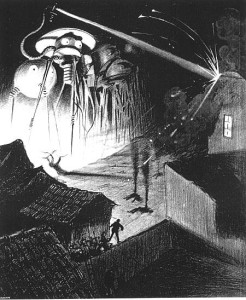 John Christopher’s Tripods is almost the definition of a forgotten gem: a work so influential that we see its effects pervasive throughout modern fiction and yet few realize where the influence originally came from.
John Christopher’s Tripods is almost the definition of a forgotten gem: a work so influential that we see its effects pervasive throughout modern fiction and yet few realize where the influence originally came from.
The Tripods trilogy, consisting of The White Mountains, The City of Lead and Gold, and The Pool of Fire, is a young adult science fiction story about a future Earth that has been invaded and conquered by Tripods – gigantic, three-legged machines controlled by unseen aliens. The alien overlords have enslaved humanity through the use of ‘caps’, implants that allow them to suppress and control thought. In The White Mountains, young protagonist Will fears his upcoming capping ceremony (to be performed on his 14th birthday), and so with his friends Henry and Jean-Paul in tow, he flees his home seeking the legendary human resistance located somewhere in the White Mountains. Over the next two novels, the boys face more challenges, as Will is captured and subsequently rescued, and the trio eventually helps overthrow the reign of the alien masters in The Pool of Fire.
The imagery of towering alien tripods has persisted to this day, such as in video games like Half-Life 2 and Crysis, but though Christopher may have helped popularize tripods, he can’t take credit for imagining them himself. That honor would appear to go to H. G. Wells, whose iconic novel The War of The Worlds featured massive Martian tripods armed with heat rays and sporting fearsome dangling tentacles. Nor did Christopher popularize the idea of alien mind control through his ‘caps’, an idea which was explored almost two decades earlier in Robert Heinlein’s The Puppet Masters. So how exactly is the Tripods trilogy so iconic, then? The answer, I think, lies in the novel’s genre, plot devices, and themes.
You see, the Tripods trilogy is an interesting beast. It’s a dystopian, post-apocalyptic adventure story. Nowadays, that sort of story is a dime a dozen. In fact, the market is so over-saturated with YA dystopian novels that editors will (almost without exception) not even consider buying them. However, The White Mountains was first released in 1967, and at that point in time, such stories were virtually unheard of. John Christopher expertly evoked images of 15th and 16th century Europe and merged them with imagery of a deteriorated industrial society to create a ‘lost-technology’ society, which, again, is very much in vogue now but was rather novel at the time.
In addition, Christopher also used plot devices that are now extremely popular in modern YA fiction. For example, in The City of Lead and Gold, Will, Henry, and Jean-Paul enter an Olympics-style competition where the winners are offered as tribute to their alien overlords. Sound familiar? If you’ve read The Hunger Games or any of a host of other recent YA sci-fi/fantasy books, it should. Not to say that Christopher came up with the competition plot device, as he certainly didn’t, but, like his use of setting and his ability to create a compelling atmosphere, he used this and other plot devices to create a memorable, cohesive story.
Now, to be fair, while I’ve labeled the novels as young adult, the fact is that they are more likely middle grade works, and as such, it has been a very long time since I have read any of them. Therefore, I cannot vouch for whether or not they would serve as entertaining reads for adults. What I can say, however, is that they’re extremely fun reads for young boys, and at least for me, they helped create enduring imagery that has lasted into adulthood.

Just finished reading the trilogy (I had the first book since I was a kid but didn’t read it until recently) and I must admit that it was a really cool reading, even as a 23 year old sci-fi enthusiast !
There is a truly special and original atmosphere throughout the trilogy, and some really serious themes are explored by the author if you read between the lines so it is not dull to read. The only downside of the fact that it is aimed for young people is that it feels kind of rushed and it ends fast compared to adult litterature… But at least there is no risk of not finishing the books ! 🙂